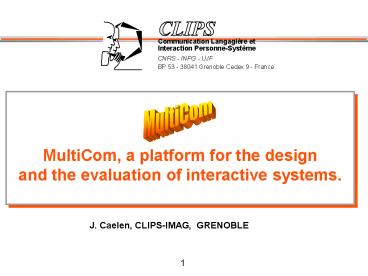Training - PowerPoint PPT Presentation
1 / 18
Title: Training
1
MultiCom, a platform for the design and the
evaluation of interactive systems.
MultiCom
J. Caelen, CLIPS-IMAG, GRENOBLE
2
Needs
- The designers of interactive systems need tools
and methods for system design and evaluation. - The academic research teams are sought
frequently by the industry for studies on user
needs, and on user evaluation. - It would be more benefit, to create a common
platform for the both partners. The platform
would be more a service centre devoted to the
experimentation than a classical academic or
industrial institution.
3
Objective
A platform for the design and the test of
interactive systems, allowing to - study the
usage and the usability of the interactive
systems under real conditions of using - design
and assess complex systems to respect with the
usage and the usability - analyse the human
behaviour (under definite scenarios of using)
from collected data
4
Expected benefits
- Improved feasibility assurance of development
projects, - Improved procedures, methods and concepts,
- Reduced development costs and time,
- Improved product quality and increased
flexibility and adaptability, - Progress towards the establishment of software
engineering standards, - Improved guarantees to end-users that a product
has been developed following best software and
cognitive engineering practice.
5
Rationale
- MultiCom is an approach to software development
which emphasises the use of operational models
throughout the lifecycle. - MultiCom is a complete platform for the design
and the evaluation of the interactive systems,
including all the stages of the development cycle
and supporting tools for sociologic observations
and ergonomic tests (by taking into account human
factors). - MultiCom provides training to the end-users as
soon as the system comes in the exploitation
phase.
6
The complete lifecycle
- A Observing the current usage, predicting the
future usage, - B Defining the specification notebook,
- C Defining the using scenario and assessing it,
- D Refining the specification on the diagnosis
delivered in C, - E Developing a mock up,
- F Evaluating the use and the usability of the
mock up, - G Modifying after debriefing and debugging,
- H Developing another version of the mock up,
- I Returning at the step F while it is
necessary, - J Evaluating the final mock up,
- K Developing a prototype,
- L Pushing it on the market,
- M Training end users if needed,
- N Analysing the market returns.
7
The pre-development lifecycle
Specific approach to enrich the product concept
as soon as possible, before the first stage of
the pre-development, using a complete parameters
palette (a) sociological questionnaires, (b)
human factors grid and task analyses, (c) data
collected from users
Correct.
Mock up 2
Test
Criteria
Mock up 1
Diagnosis
Functions
Criteria
Virtual interface
Concept
Devel.
Specification
Scenario
Functions
Test
8
The design cycle
To integrate as soon as possible the human
factors in the design process three phases
Information Elicitation Phase Design Synthesis
Phase Design Specification Phase
Correct.
Mock up 2
Test
Criteria
Mock up 1
Diagnosis
Functions
Criteria
Virtual interface
Concept
Devel.
Specification
Scenario
Functions
Test
9
MultiCom Tools
- Simulation
- Measure
- Analysis
- The platform
- rooms
- workstations
- audio-video
10
Tools simulation
- The simulation consists in
- simulate a product/system using some virtual
reality tools, - or simulate a situation (using wizard of Oz
method), - or simulate the situation and the product
together.
11
Tools measure
- The simulation
- The measure consists in
- choosing adequate criteria,
- selecting parameters,
- defining scenarios and test protocols,
- collecting data about the user behaviour,
- applying criteria on the selected parameters.
12
Tools analysis
- The simulation
- The measure
- The analysis consists in
- making functional analysis or task analysis
before the specification phase, - applying reverse engineering method during the
specification phase in order to validate it, - applying statistical methods on collected data
after the development phase, - studying spoken dialogues if any.
13
Methods
- By prediction from socio-cognitive theory to
specify the design and to specify the system. - Materials questionnaires,
- task trees,
- sociological criteria grid
14
Methods
- By prediction
- By simulation (virtual prototype, wizard of Oz,
etc.) in order to refine functionality and to
control the level of usability of the prototype,
during the development phase.
15
Methods
- By prediction
- By simulation
- By direct observation on the prototype working
in applying assessment protocol, - Materials scenario editor,
- observation scripts and annotation,
- data collecting software,
- data analysis tools,
- simulation tools.
16
Methods
- By prediction
- By simulation
- By direct observation
- By indirect observation in verifying the
conformity of the system to the specifications. - Materials ergonomic expertise.
17
Benefits to the developing countries
- Last years, usability budgets have been steadily
growing... - Costs for a usability labs ? Not really a
problem... - Sharing equipment
- Sharing specialists
- Portable equipment
- Usability laboratories can also be used for
certain variants of heuristic evaluation (for the
design phase but also for the adaptation to the
user and for the computerisation phase) - The single-most important decision in usability
engineering is simply to do it !
18
Conclusion
- MultiCom is
- A competence network (sociology, ergonomics,
computer science) - A complete platform of experimentation and
measure - A training centre (seminars, short courses)
- A resource centre offering services on sociology
and human factors areas
MultiCom































